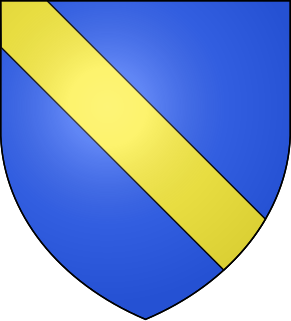14th-century Scropes

The great-great-great-grandson of Hugh was Sir William le Scrope (c.1259 – c. 1311) of Bolton, in Wensleydale, Yorkshire, who had two sons, Henry le Scrope (died 1336) and Geoffrey le Scrope (died 1340), both of whom were in succession chief justice of the king's bench and prominent supporters of the court in the reign of King Edward II of England. [1]
Richard le Scrope (c. 1327 – 1403)
Henry was father of Richard Scrope, 1st Baron Scrope of Bolton (c. 1327 – 1403), chancellor of England, an active adherent of John of Gaunt. [1]
William le Scrope (c. 1350 – 1399)
His eldest son William le Scrope (c. 1350 – 1399) was created Earl of Wiltshire in 1397 by Richard II, of whose government he was an active supporter. Wiltshire bought the sovereignty of the Isle of Man from the Earl of Salisbury. In 1398 he became Treasurer of England. His execution at Bristol was one of the first acts of Henry IV, and the irregular sentence of an improvised court was confirmed by Henry's first parliament. Wiltshire' father, Lord Scrope, and his other sons were not included in the attainder, but received full pardon from Henry. Scrope, who was the builder of Bolton Castle, his principal residence, died in 1403. He was succeeded in the barony by his second son, Roger, whose descendants held it till 1630. [1]
Geoffrey le Scrope (d. 1340)
Sir Geoffrey le Scrope (died 1340), chief justice of the kings bench as mentioned above, uncle of the first Baron Scrope of Bolton, had a son Henry, who in 1350 was summoned to parliament by writ as Baron Scrope, the designation of Masham being added in the time of his grandson to distinguish the title from that held by the elder branch of the family. Henry's fourth son was Richard le Scrope (c. 1350 – 1405), Archbishop of York, who took part with the Percys in opposition to Henry IV, and was beheaded for treason in June 1405. Despite this, Henry Scrope, 3rd Baron Scrope of Masham (c. 1376 – 1415), became a favourite of Henry V, by whom he was made treasurer in 1410 and employed on diplomatic missions abroad. However, in 1415 he was involved in a conspiracy to assassinate Henry (along with the King's cousin Richard of Conisburgh, 3rd Earl of Cambridge) and was ignominiously executed at Southampton. His title was forfeited. It was, however, restored to his brother John in 1455; and it fell into abeyance on the death, in 1517, of Geoffrey, 11th Baron Scrope of Masham, without male heirs. [1]









